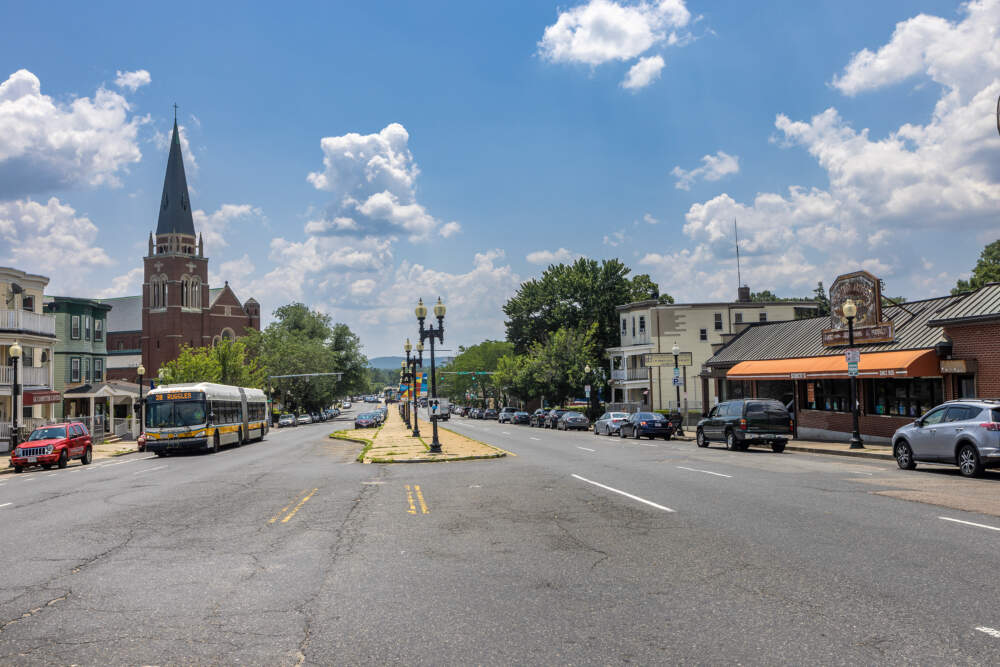Advertisement
Blue Hill Avenue is getting a $44 million redesign, including a center-running bus lane

Blue Hill Avenue is getting a much needed and long overdue makeover. Boston Mayor Michelle Wu on Wednesday announced a $44 million investment to redesign the major corridor to make it safer and more efficient for bus riders, pedestrians and drivers. The plan comes after a two-year community engagement process.
The core feature of the redesign will be a dedicated bus lane in the center of Blue Hill Avenue from Mattapan Square to Grove Hall in Dorchester, one of the city's busiest corridors. The design is a key element of bus rapid transit, a faster and more efficient bus system that's been used in many parts of the world for years. In this system, buses are set up sort of like the above ground portions of the MBTA's Green Line. The buses and bus stops are located in their own separate space in the center of the road, which keeps the buses away from curbsides and cars. New England's first center-running bus lane opened on Boston's Columbus Avenue in 2021.
The changes will be implemented along a 3-mile stretch between River Street and Warren Street. The corridor is a crucial part of the MBTA's network. It's also where some of the city's fare-free buses operate. The city estimates a dedicated bus lane will cut down bus travel on this corridor from 1 hour to 25 minutes.
"We know it will make a huge impact to predictability and having more streamlined, efficient commutes for everyone who's trying to get around on this corridor," Wu said during a press briefing Tuesday.
More than half of all travelers on Blue Hill Avenue ride buses, according to the city. And there are more than 37,000 bus riders on the corridor every weekday. Those bus riders collectively lose more than 3,000 hours per weekday due to traffic, according to the city.

The Blue Hill Avenue redesign project will also include roadway repairs, more crosswalks and wider sidewalks. The city will also re-time traffic signals to ensure a smoother flow of vehicles.
The corridor has a lot of safety issues that city officials believe the redesign will address. There is a crash on Blue Hill Avenue requiring Boston EMS every three days on average, according to the city. And the number of vehicle crashes per half mile is in the top 3% of Boston streets.
"Blue Hill Ave. is incredibly chaotic" because of the amount of double parking in front of businesses, confusing intersections and traffic congestion, the city's chief of streets Jascha Franklin-Hodge said.
The goal of the project is to "better organize the street" to make it "a multimodal corridor that is safe for all forms of transportation," Franklin-Hodge said.
The city will also plant more trees on the corridor to increase canopy cover, and install new amenities such as benches, bike parking and public art.
Advertisement
Kevin Canty, of Walnut Deluxe Cleaners on Blue Hill Avenue, said the area is long overdue for a facelift.
"I’m hopeful that the city’s investment in this community will usher in a resurgence in viability for the businesses that currently exist in this area as well as those with future interest in setting up shop along this route," Canty said in a statement.
The redesign of Blue Hill Avenue will take years to fully implement. The final design for the corridor has not yet been determined. So it's not yet clear how many travel lanes there will be in the final design, but they will likely "vary at different points in the corridor," Franklin-Hodge said. The city will engage residents and local business owners block-by-block over the next several months to determine the right mix of parking spaces, pedestrian infrastructure, green space and travel lanes. The city will also consider potential bike lanes, according to Franklin-Hodge.
City officials expect to finalize the design and put the project out to bid in the winter of 2025. And the bulk of construction is expected to start in 2026.
However, some changes to the corridor will begin this spring with fixes to the current infrastructure. That work will include: installing better street lighting, putting new speed humps on neighborhood streets, refreshing pavement markings to make them clearer, and repairing damaged pavement, potholes and sidewalks. The city also plans to install new shade structures and green roofs on existing bus shelters to help mitigate the impact of extreme heat and flooding due to heavy rainfall.
The $44 million Blue Hill Avenue redesign project is funded by a $15 million grant from the U.S. Department of Transportation, $11 million from the MBTA and $18 million from the city of Boston.
